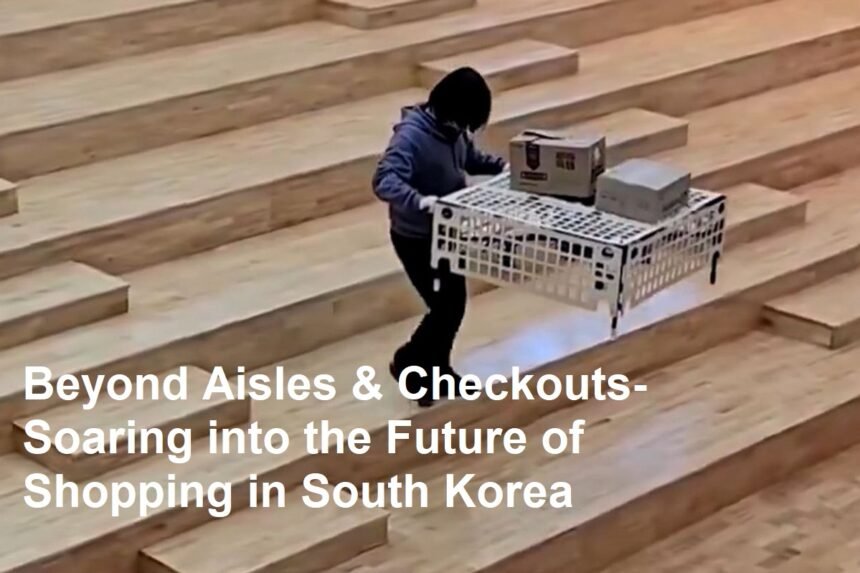Introduction
Imagine gliding through a vast department store, your shopping cart hovering effortlessly beside you, anticipating your needs and whisking away purchases without a single queue. While the literal image of flying shopping carts might still belong to science fiction, South Korea’s retail landscape is pioneering innovations that feel equally revolutionary, fundamentally transforming the concept of “shopping” into a seamless, tech-driven, and increasingly “hands-free” experience. Forget cumbersome trolleys; the future of Korean retail is about digital agility and automated convenience.
The Foundation: Digital Integration Everywhere
South Korea didn’t leap straight to flying carts; it built a runway of unparalleled digital infrastructure. Long before “flying” became a metaphor, Korean retail perfected the art of frictionless digital shopping:
- Omnichannel Mastery:Blurring lines between online and offline is standard. Order groceries via app (like Coupang Eats or Market Kurly) for lightning-fast delivery – sometimes within hours. Click-and-collect services are ubiquitous. Major department stores (Shinsegae, Lotte) offer apps allowing virtual browsing, real-time stock checks, and in-store navigation.
- Cashless & Contactless Reign:Physical wallets are nearly obsolete. Credit/debit cards, mobile payments (Samsung Pay, KakaoPay, Naver Pay), and even transit cards (T-money) are used universally. Facial recognition payments are emerging, eliminating even the need to pull out a phone.
- Smart Stores & AI Assistance:Convenience stores (CU, GS25, 7-Eleven) are increasingly unmanned or feature self-checkout with AI surveillance. Stores utilize smart shelves with weight sensors and digital price tags. Interactive mirrors in beauty stores (like Olive Young) offer virtual try-ons and product recommendations. AI chatbots handle customer inquiries 24/7.
Taking Flight: The “Flying Cart” Metaphor Takes Shape
This hyper-digital environment creates fertile ground for concepts that embody the spirit of a “flying shopping cart” – automation that removes physical burdens and streamlines the journey:
- Drone Delivery – The True “Flying” Element:This is where the “flying” part becomes literal. Companies like Coupang, leveraging its “Rocket Delivery” network, are actively testing and deploying drone delivery services, particularly in less accessible areas (islands, mountainous regions). While not carts hovering beside you in-store, these drones represent the most direct manifestation of “flying” logistics, autonomously transporting purchases from distribution hubs directly to customers’ doorsteps, bypassing traditional ground transport limitations. Imagine ordering a last-minute gift and having it arrive via drone!
- Automated Warehouses & Logistics:Behind the scenes, the magic happens in highly automated fulfillment centers. Giant retailers like Lotte Mart and Shinsegae employ armies of robots that fetch items, sort packages, and prepare orders with incredible speed and accuracy. These robotic systems are the “flying carts” of the back-end, ensuring your online order is processed and dispatched near-instantly.
- In-Store Automation:While full hover-carts aren’t here yet, automation within stores is growing. Some experimental stores or specific sections (like Lotte’s “Pick&Go” at Seoul Station) use smart carts with scanners or shelf sensors that automatically add items to a virtual cart as you pick them up, allowing for instant payment via app without traditional checkout lines. Conveyor systems whisk purchased items directly to packaging or pickup points. This automation handles the “cart” function invisibly.
The Shopping Experience: Effortless and Immersive
The result for consumers is profound:
- Unprecedented Convenience:Need groceries? Order via app, get drone delivery on your balcony (in pilot areas), or have them ready for curbside pickup within minutes. Forget lugging heavy bags.
- Time Saved:Hours spent navigating aisles and waiting in lines are drastically reduced. Automation handles the logistics.
- Personalization:AI analyzes your purchases (with consent) to offer tailored recommendations, both online and increasingly in-store via digital displays or apps, acting like a personal shopping assistant.
- Enhanced Discovery:AR apps let you visualize furniture in your home before buying. Interactive displays provide deep product information instantly.
The Future is Landing
While fully autonomous flying carts accompanying shoppers inside malls remain futuristic, South Korea is undeniably pioneering the essence of what that concept represents: a shopping experience liberated from physical constraints and friction. The relentless focus on digital integration, automation, robotics, and now drone delivery creates an ecosystem where purchases seem to almost magically appear, guided by invisible, intelligent systems.
Shopping in South Korea today is less about navigating aisles with a clunky trolley and more about seamlessly interacting with a sophisticated, responsive retail network. The “flying shopping cart” isn’t necessarily a physical object yet; it’s the feeling of effortless acquisition, powered by technology that handles the heavy lifting, leaving you free to browse, discover, and enjoy. As drone trials expand and in-store automation advances, the line between science fiction and Korean retail reality continues to blur, offering a thrilling glimpse into a truly frictionless future of consumption. The journey has already taken flight.












